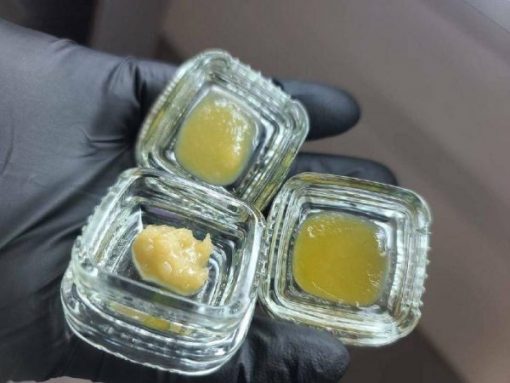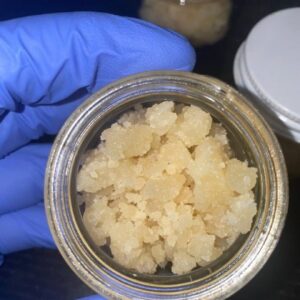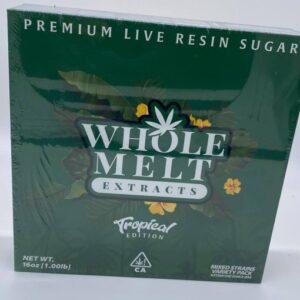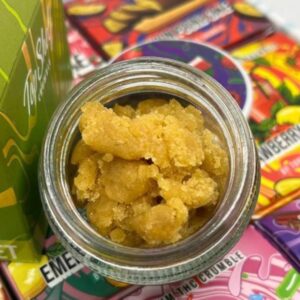Buddery Crash Live Rosin
Buddery Crash Live Rosin When discussing the merits of live resin vs. rosin, there are a lot of angles to consider both for brands and consumers. Both concentrates can pique the interest of consumers while providing brands with lucrative, highly sought-after SKUs.
But what are rosin and live resin? A fair deal of confusion can be expected when first entering the space. There is never any shame in asking what is live resin or what is rosin, especially when first stepping into the cannabis market. These two extracts are just the tip of a seemingly ever-growing iceberg of concentrates. Between solventless and solvent-based extracts, the varieties are seemingly endless, but some key distinctions allow customers to purchase a product that best fits their needs and budget.
Today’s focus will mainly center on the rosin vs resin debate, touching on what exactly makes both so popular, how they’re form, and which one is the best choice for consumers and businesses alike.
LIVE RESIN VS. ROSIN: WHAT’S THE DIFFERENCE?
Before diving into the nuances of live resin and live rosin, it is essential to mention that both are cannabis concentrates, or extracts, depending on who you ask. While they fall under the same broad umbrella, live resin, and live rosin have substantial differences, essentially putting them on opposite ends of the resin extract spectrum, despite being made from similar source material. Now, let’s explore some of those key differences.
Golden in color and often granular in appearance, live resin stands out in several ways beyond our sight and smell. Primarily, it can be considered a step above the rest of the pack of concentrates made with solvents. Live resin serves as one of the best reasons to extract using fresh frozen flowers when using hydrocarbon processing. The process helps retain the natural terpenes lost during the cultivation and extraction process used by numerous other popular concentrates on the market that use dried, cured cannabis instead.
A significant selling point to the live resin full-plant experience is its potency. Like other extracted items, live resin helps increase the strength of a cannabis product well above the flower. Depending on its source material and production process, live resin’s THC percentage can reach between 65% and 95%.
HOW TO MAKE LIVE RESIN
While making live resin requires skill and precision, once mastered it is a pretty routine process that entry-level lab technicians can handle easily. When performed correctly and using top-tier plant material, the result is one of the most potent and pliable products around. That said, the live resin extraction process requires pressurized hydrocarbons and is not always made with premium quality material.
To reiterate, the key to live resin’s success is found in the first step and its use of fresh frozen flowers. Instead of beginning the drying and curing phase, the freshly harvested flower is flash-frozen in subcritical temperatures around -20°F to -40°F to lock in the plant’s freshness and profile. The clipped cultivars remain frozen throughout the extraction process. Typically, producers begin extracting within a day and a half of harvesting. At this point, the live resin begins to resemble other solvent-based extraction methods. The frozen plant material is introduce to hydrocarbon solvents which pass through the flower, and dissolve the cannabinoids and terpenes into a resinous mixture. The most common solvent use is butane, but combinations of propane and ethane are sometimes use as well.
HOW TO MAKE ROSIN
Rosin, to make it properly, takes its fair share of skill as well. Unlike live resin, making rosin is a more straightforward method but requires a material that is completely contaminant free. Also, like live resin, there are variances in the rosin extraction method. Most producers follow a relatively similar process that, that relies on solvents, focuses on a process that is refine for decades.
Before diving into how the professionals make rosin today, we want to give the nod to the extraction process’s innovators, namely Soilgrown, who is credited with being the first person to discover modern rosin. Those early extractors that found dual uses for a hair straightener helped shape the rosin-making process into what it is today. While the trend is fading away thanks to specialized equipment, scores of DIY producers still rely on the hair straightener rosin method. While it won’t yield the top-tier, high-volume quantities needed for a business, the old-school method can do enough of the trick for personal and small-batch use.
HOW TO MAKE ROSIN WITH A ROSIN PRESS
The creation of rosin pressing-specific equipment served as a game-changer for producers and consumers alike, allowing for the creation of products that enable rosin to reach its full potential as a potent, versatile extract. Dedicated equipment helped provide rosin producers with what DIY tools could not: even heat, consistent pressure, and overall improved yields by a significant amount.
Producers can go one or several routes using a rosin press machine, using either flower, hash, or dry sift as their inputs. While newer producers may opt for flower because of its low cost and ease of pressing, it doesn’t tend to make a product that connoisseurs are looking for compared to high-quality ice water hash or sift rosin. That said, the vast majority of solventless producers prefer using live bubble hash as their starting material due to its improved quality, aesthetic, and potency. The lighter-in-color extract does require a bit more steps but results in a higher-grade extract if produced using top-grade cultivars.
WARM CURE AND COLD CURE ROSIN
The next step is critical in creating various textures and consistencies using rosin but is only really available to processors pressing hash rosin. With several options to choose from, cold cure and warm cure rosin provide extractors with ample SKU opportunities while offering consumers a bevy of textures to enjoy and put to use.
Warm curing sees collected solventless rosin placed in sealed glass containers exposed to temperatures between 90°F and 110°F. The gentle heat creates changes in the rosin, which helps separate the terpenes which can be siphon off for cartridges, diamonds and sauce, or other products. Producers can use many methods to expose extracts to the specific amount of heat, but keeping your rosin away from sunlight is very important. In certain conditions, a jar is place in a room temperature, in order to create a product similar to a wet bladder.
Other methods, like heating pads and rosin press plates, are also standard tools of the practice. Depending on the method, temperature, and length of exposure, the warm cure rosin approach should see several texture and consistency changes over time. Some hash makers also use non-pressurized tabletop ovens that enable low warming, which is convenient.
WHAT IS LIVE ROSIN?
Rosin itself is an incredible concentrate for consumers and businesses alike. So too is live rosin. Both are incredibly valuable and desirable, though there are differences to consider when comparing rosin vs. live rosin. First, what is live rosin? Unlike rosin, live rosin is form with bubble hash that is process with fresh or frozen flowers. With live resin, this retains the original essence of the cannabis plant but instead of cleaning with chemical solvents, it’s put with ice and water to separate the trichomes themselves from the cannabis buds.
Each item has the potential to do wonders for a company’s SKUs, but only live rosin can typically tout itself as the most flavorful item of the bunch due to its retained plant profile. Keep in mind that its texture will change as well. Unlike rosin and its oily nature, live rosin’s texture will more likely take on a buttery consistency when stored improperly.
WHICH IS BETTER? LIVE RESIN OR ROSIN
In the battle of live resin vs rosin, a case is form on either–with some saying the consumer wins out regardless.
The benefits of rosin and live resin can justify why a consumer would choose either. However, the decision ultimately comes down to preference. Those seeking the highest THC potency possible at the lowest price point may choose live resin. On the other hand, consumers seeking the highest quality, whole-plant consumption experience are likely to prefer live rosin. Buddery Crash Live Rosin
The choice of producers can be a bit more complicated. Until recently, it was fair to ask, ‘Is rosin profitable for my company?’ This is a new era so solventless extraction continues to close the gap in quality and yield production. Coupled with the significantly lower startup costs, it is clear that rosin and other solventless extracts are undoubtedly worthwhile endeavors for any producer. Buddery Crash Live Rosin
Are you looking to learn more about rosin, live resin, or live rosin? Be sure to contact Whole Melt Extract today!





Bella Amel –
I received regular updates about the status of my delivery, which gave me peace of mind. The communication from the delivery service was excellent.
Janet Lawson –
I had a special request for the delivery person, and they handled it with professionalism and courtesy. They made sure everything went smoothly.
Deco aves –
The delivery service has a user-friendly website and app, making it easy to place orders and track shipments. It’s convenient and efficient.”